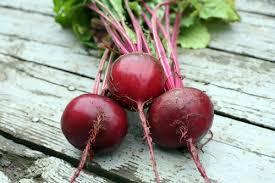Beet
-
Scientific NameBeta vulgaris
-
General InformationThe garden beet is an herbaceous biennial that is usually grown as an annual during the cooler months of the year. It is grown as a root vegetable, but the leaves can also be eaten.
 Photo: UC ANR
Photo: UC ANR -
When to Plant
Beets do best when daytime temperatures are between 60 and 65 degrees. This is typically in the spring and fall months in Marin, but they can survive some frost. They don’t like temperatures above 75 degrees. Beets typically take from five to ten days to germinate. They will not germinate if soil temperatures are below 40 degrees. The strongest plants emerge when soil temperatures range from 50 to 75 degrees.
-
Planting
Beets are almost always direct seeded but can be transplanted successfully when young. Plant in rows or scatter sow them in small blocks. Plant one-half inch deep and one to two inches apart. Thin to four inches apart when seedlings have two true leaves.
-
Soil Requirements
Best grown in sandy, loamy soil or soil well-amended with organic matter. Sensitive to soil acidity -- a pH of 6.2 to 6.8 is preferred but a pH of 6.0 to 7.5 will be tolerated. Beetroots can reach deeply into the soil with its taproot easily reaching one foot and its finer root hairs extending several feet down if the soil is well loosened.
-
Water Requirements
Plenty of moisture is needed. Water well and mulch to keep beets cool in warmer weather.
-
Fertilizing
Beets grow best in nutritious soil in deeply dug, raised beds. Be certain to amend soil at planting, adding an organic fertilizer low in nitrogen and high in phosphorus and potassium.
-
Pollination
Beets are wind pollinated, but pollination is of no concern. You will be harvesting the greens and the root. If the plant forms a flower stem, known as bolting, pull and compost as root will no longer be succulent.
-
Harvesting
Expect to harvest your mature beets around 50 to 70 days. You will be harvesting the greens and the root. If the plant forms a flower stem, known as bolting, pull and compost as root will no longer be succulent. Harvest baby beets when only one inch in diameter.
Harvest the beets at the optimum size (usually one and a half to two and a half inches in diameter) as indicated on the seed packet. -
Storage
Beets will store longer in the refrigerator if the greens are cut off leaving about one inch of stem. Store the greens separately.
-
Good Varieties for Marin
‘Detroit Dark Red’ ‘Early Wonder’ ‘Chiogga’ ‘Golden’ ‘Bulls Blood’
-
Helpful Tips
Water evenly to promote good quality roots without formation of rings. Harvest on time. Some varieties remain tender as they age in ground but most become tough and woody.
-
Common Problems
A low soil pH results in stunted growth. Warm weather can cause bolting (flowering) and is detrimental to the root.
-
Pests- Diseases & More
Beets are prone to leafminers.

